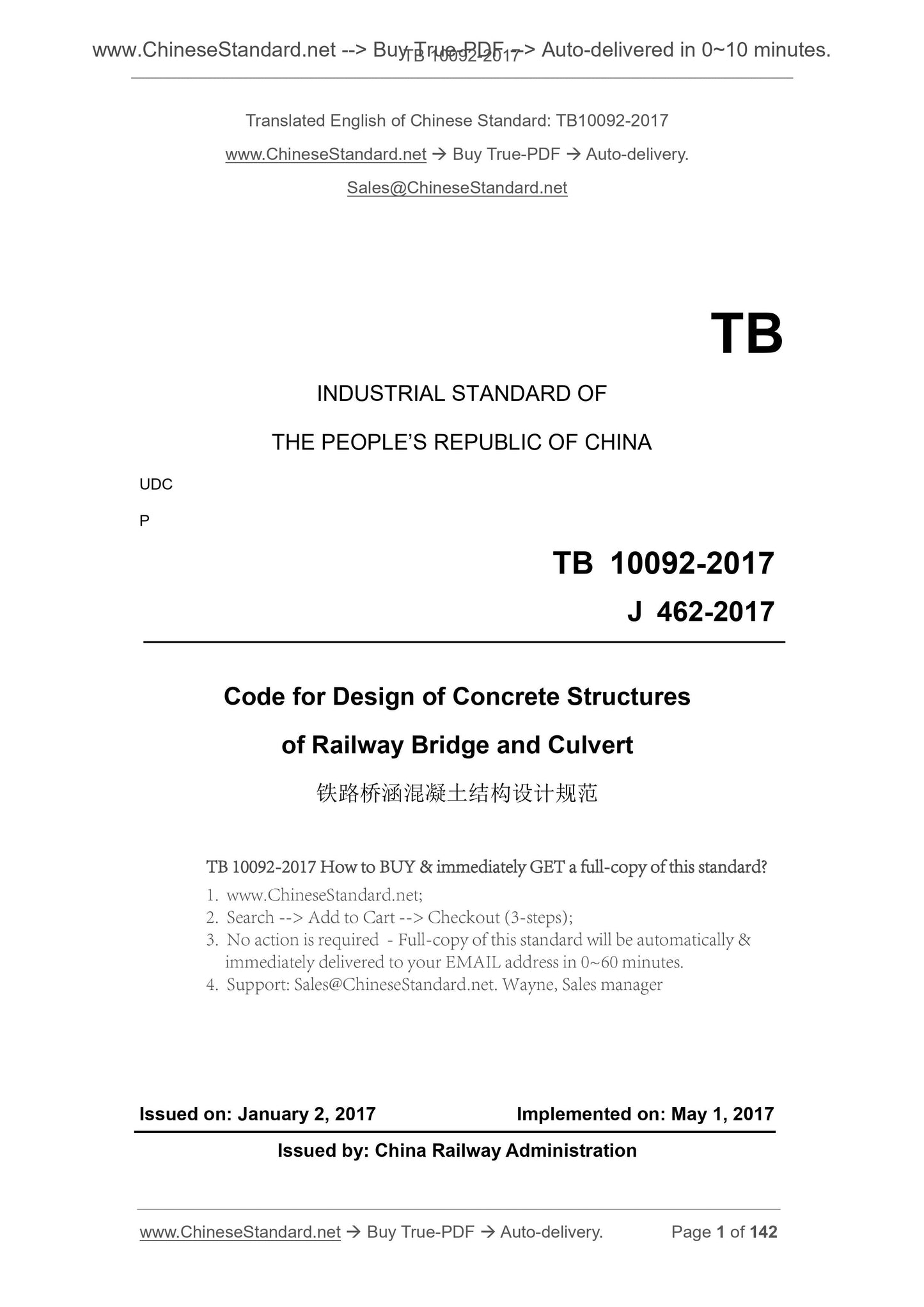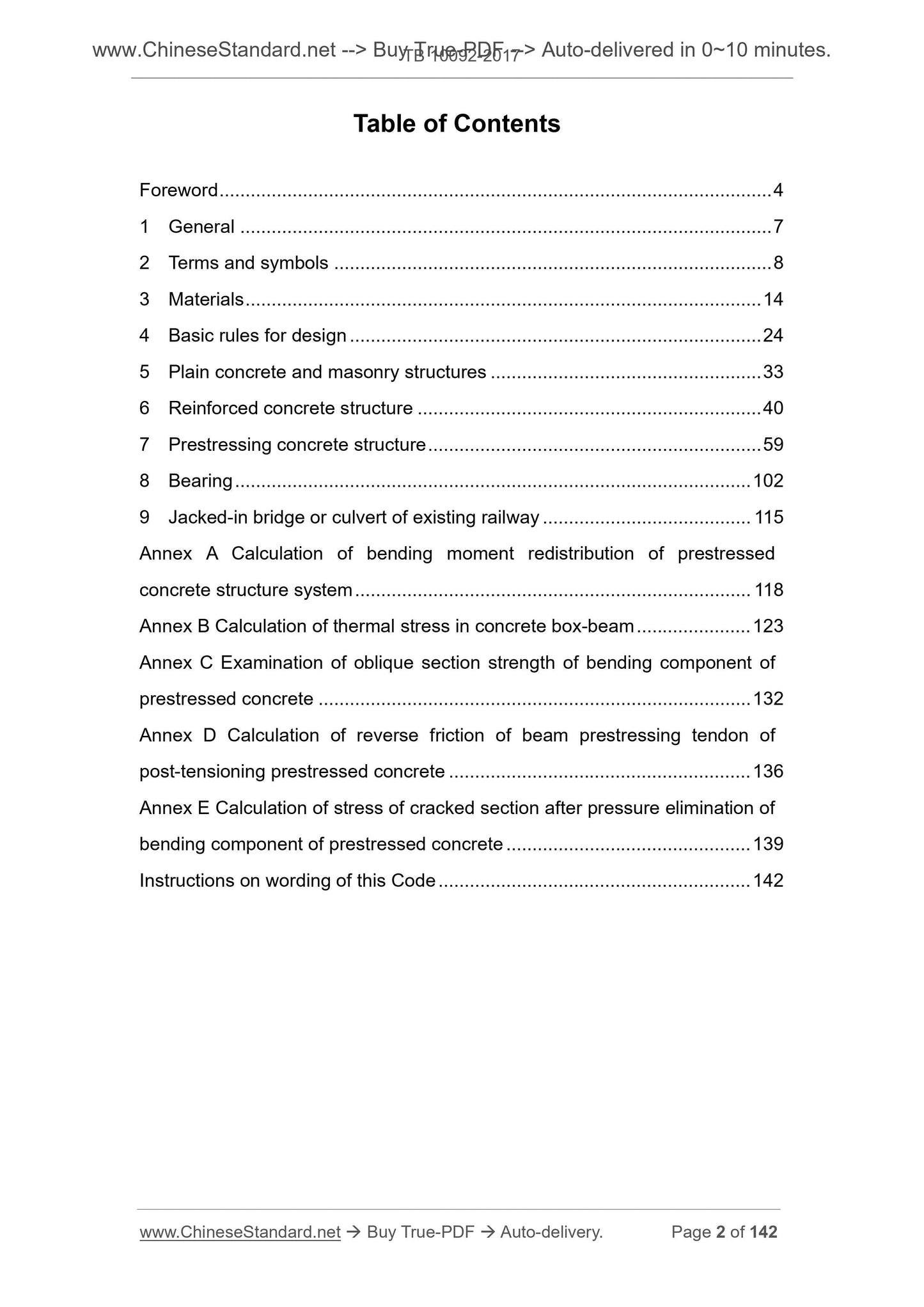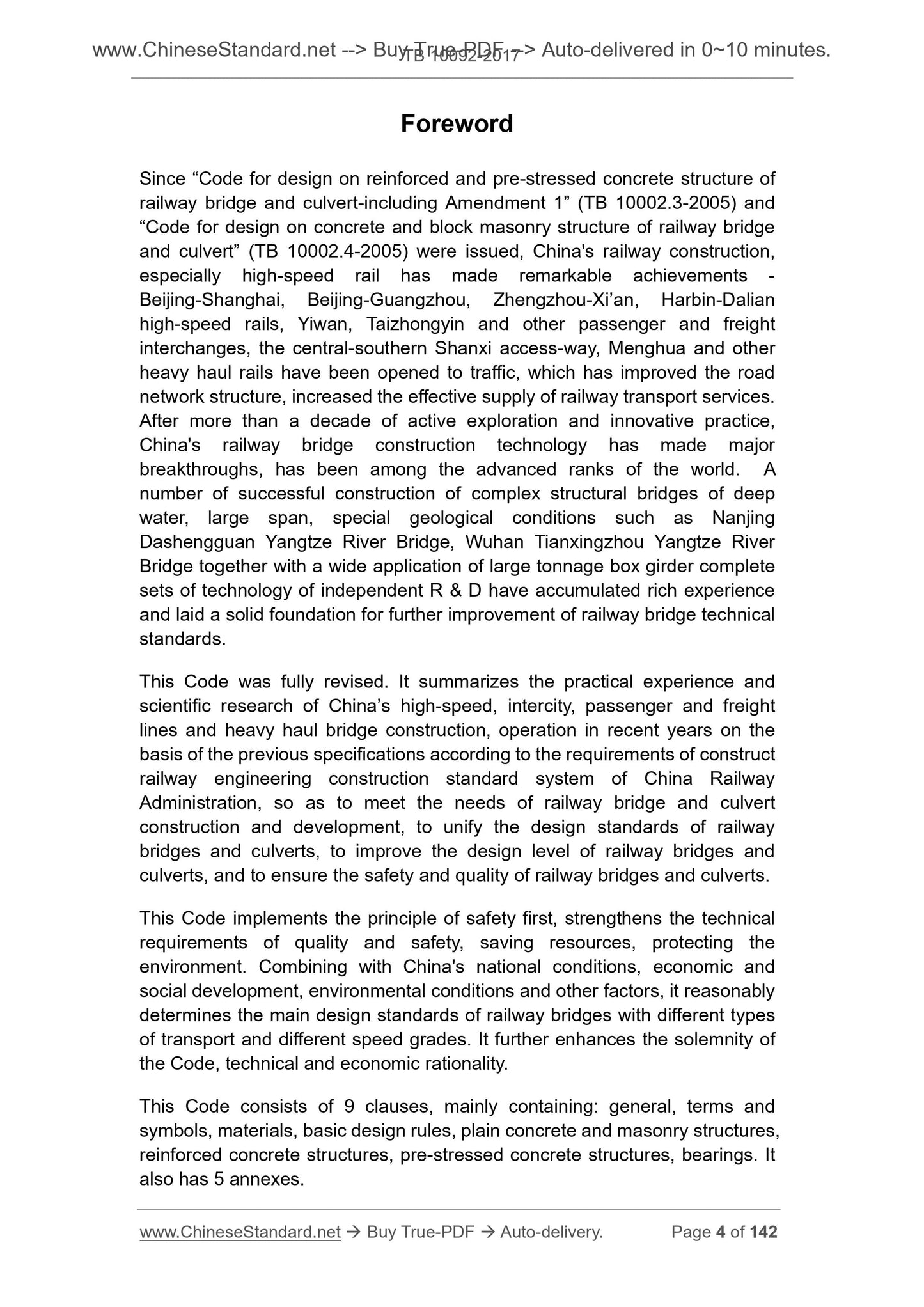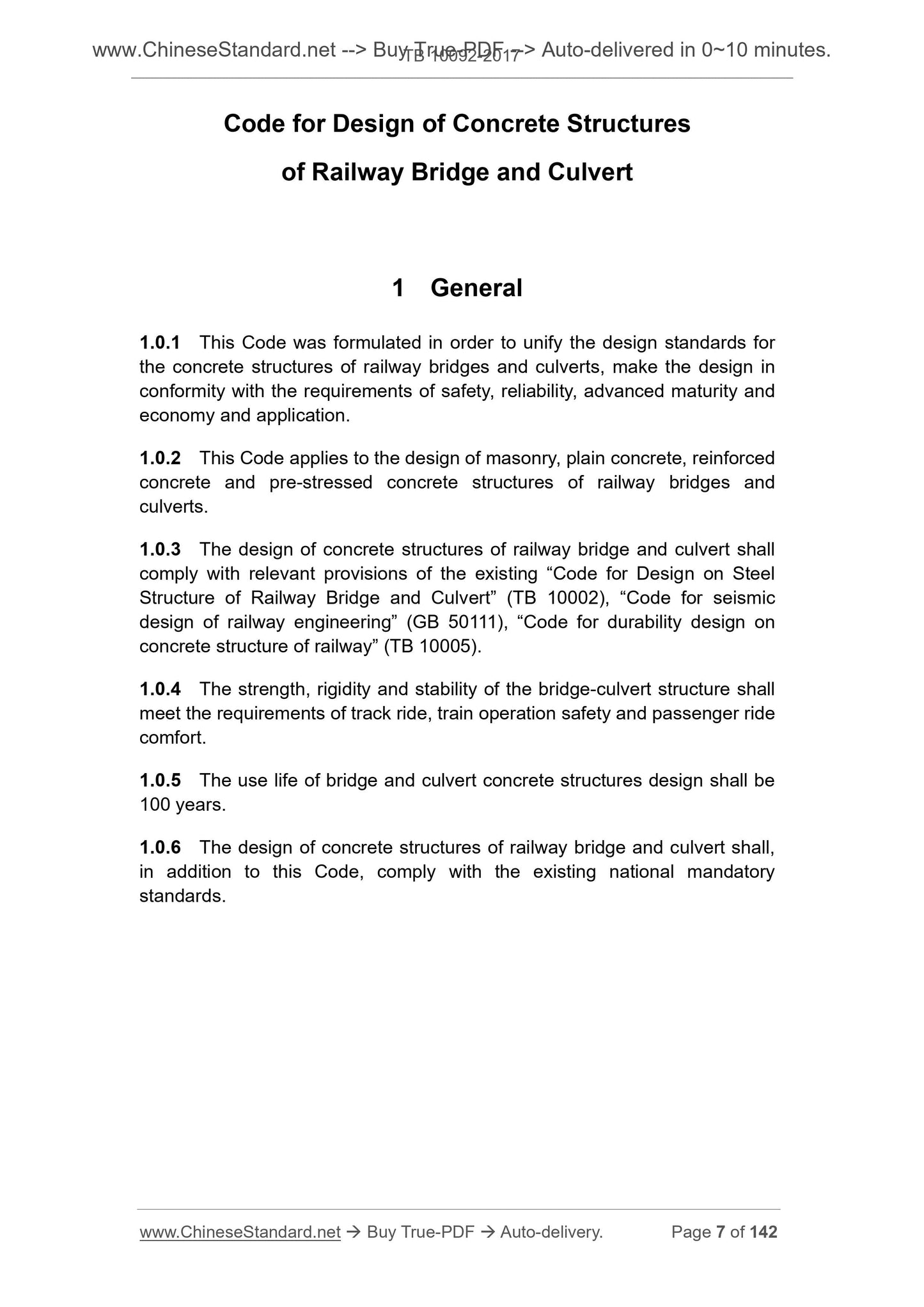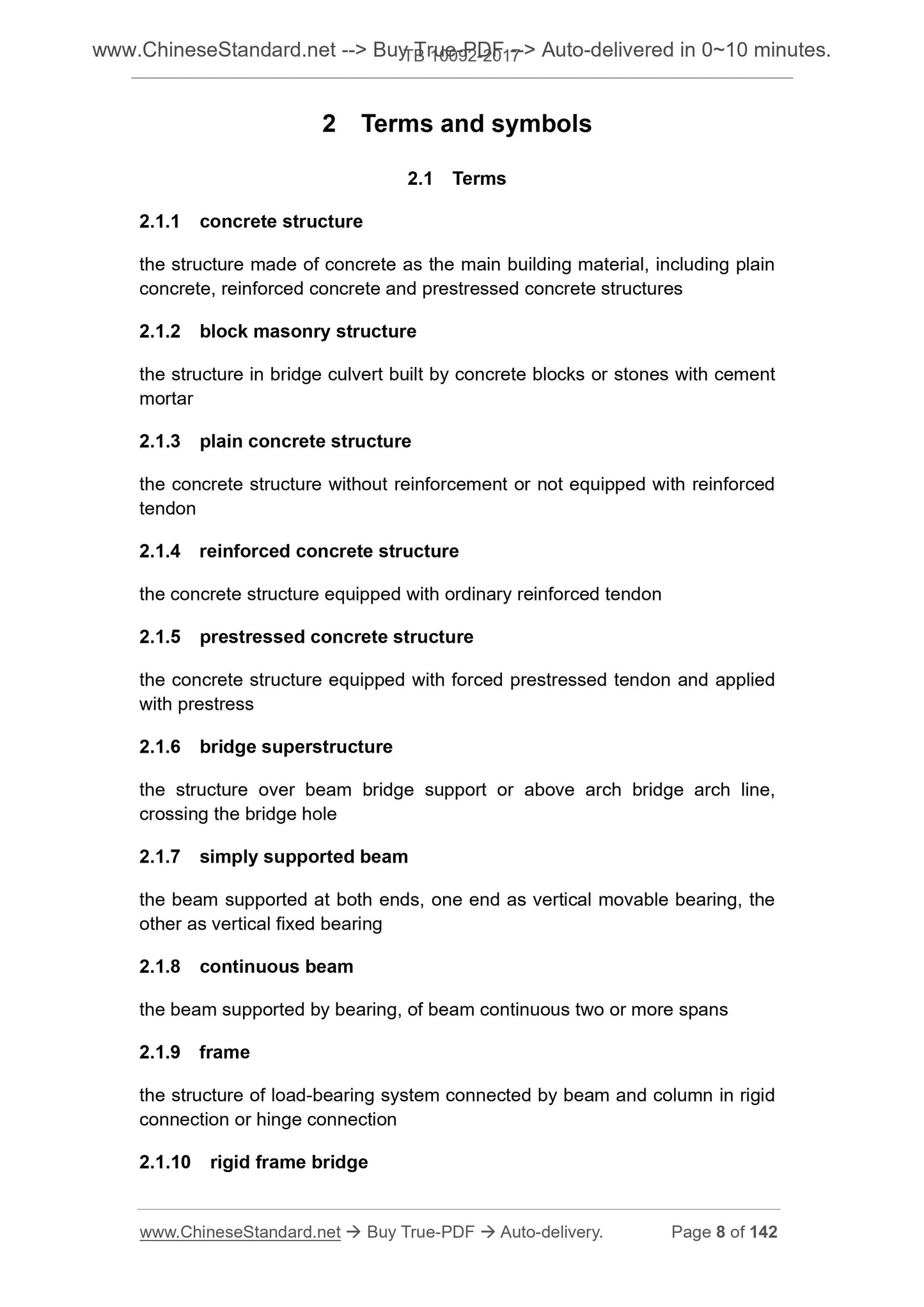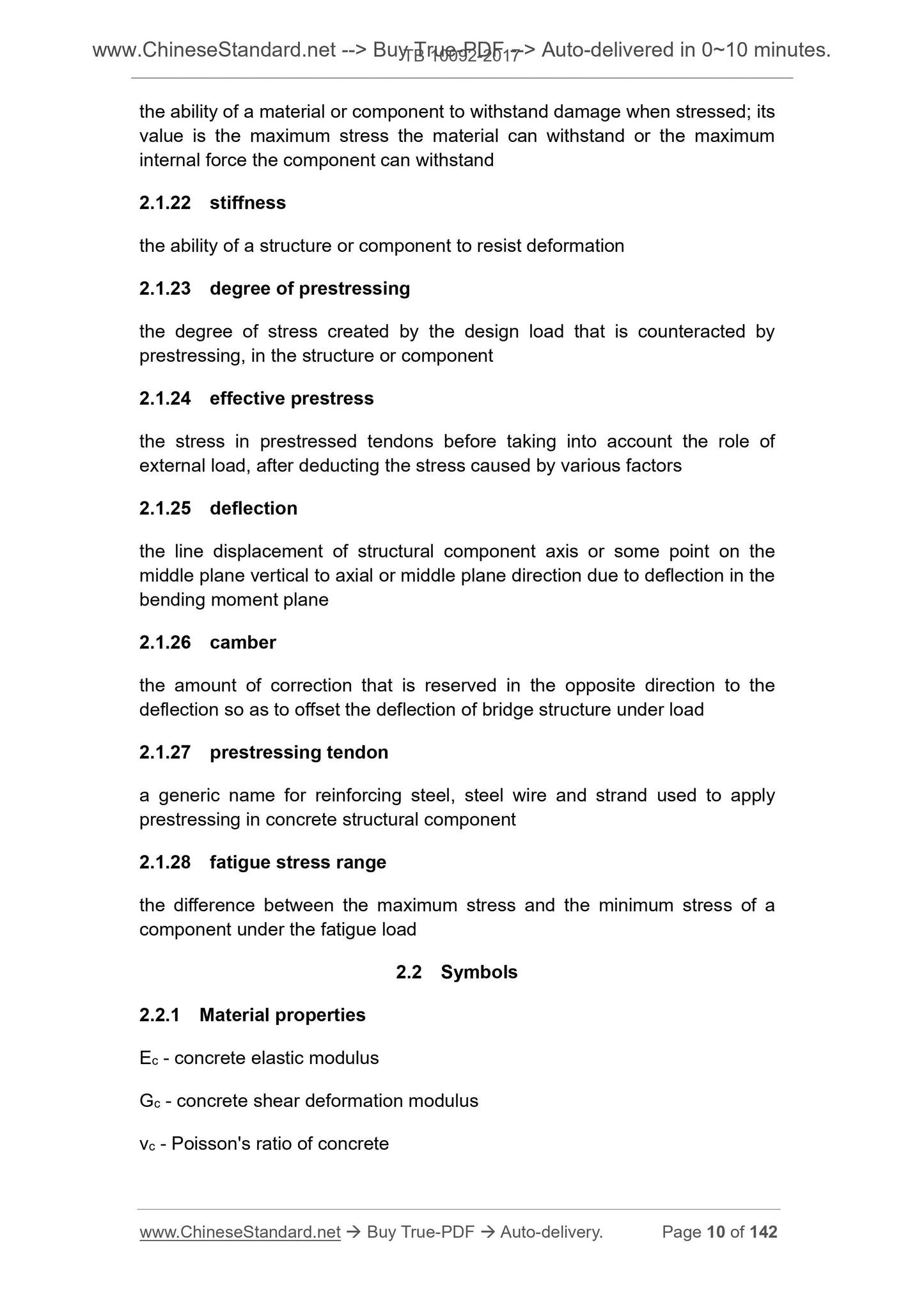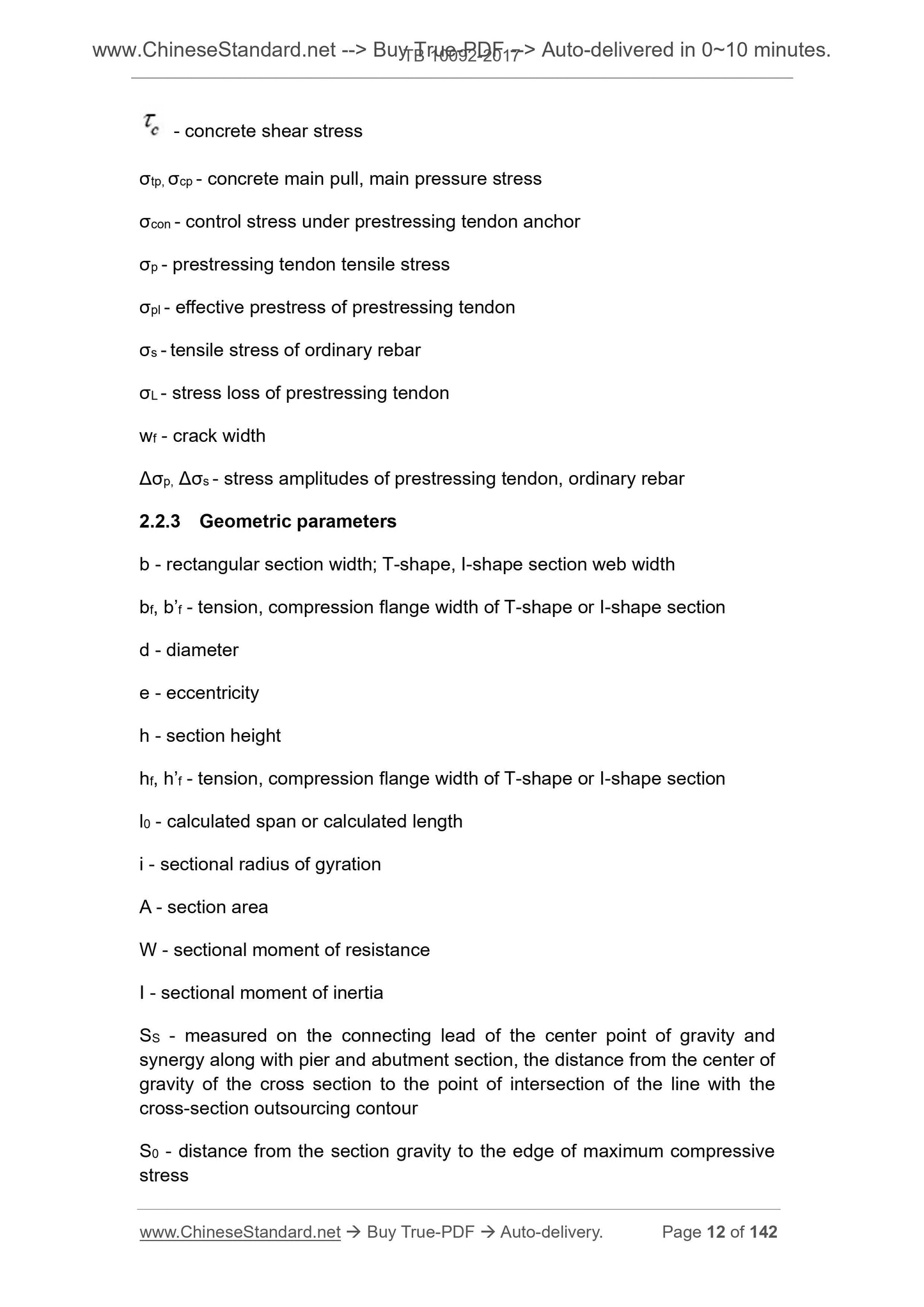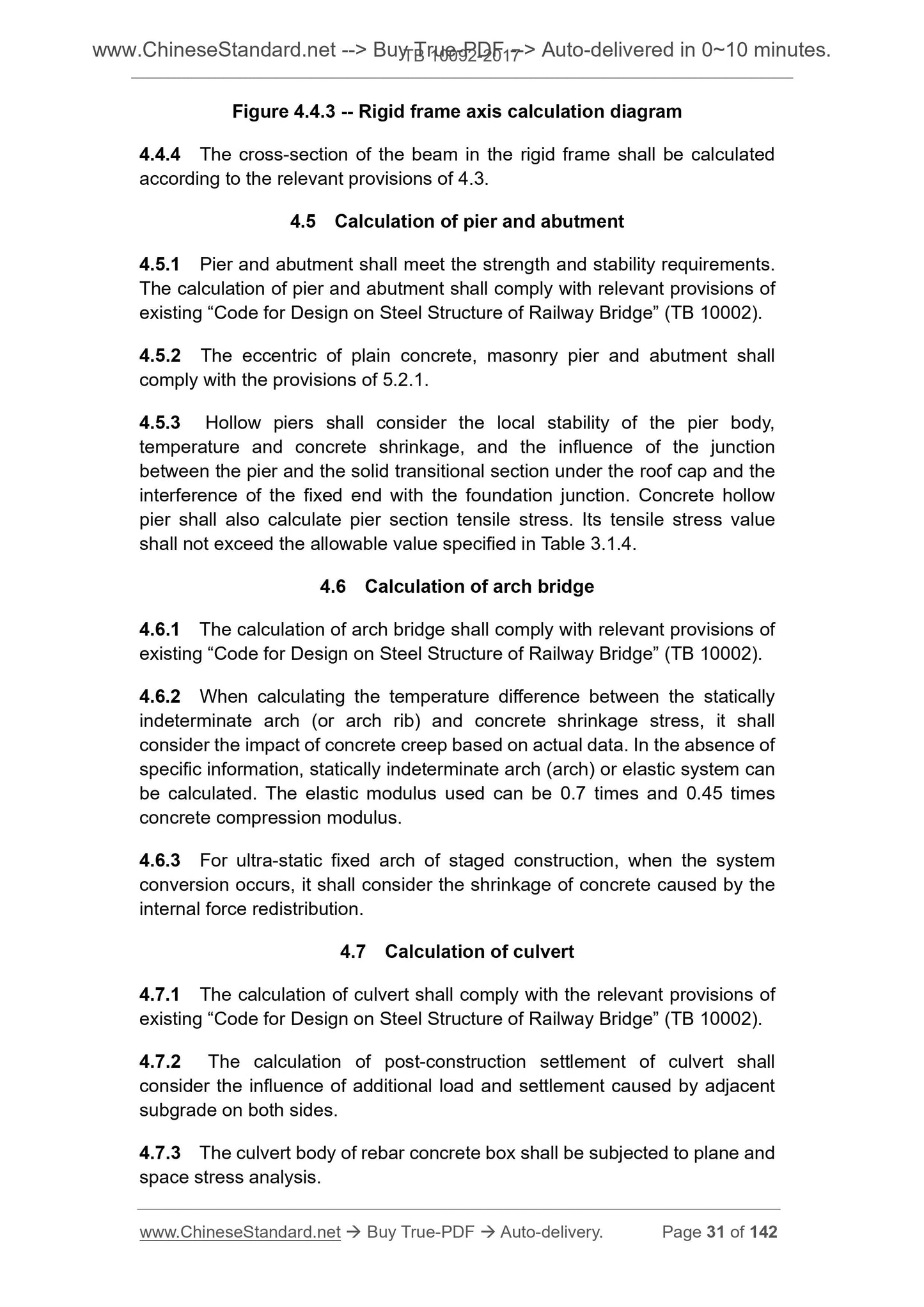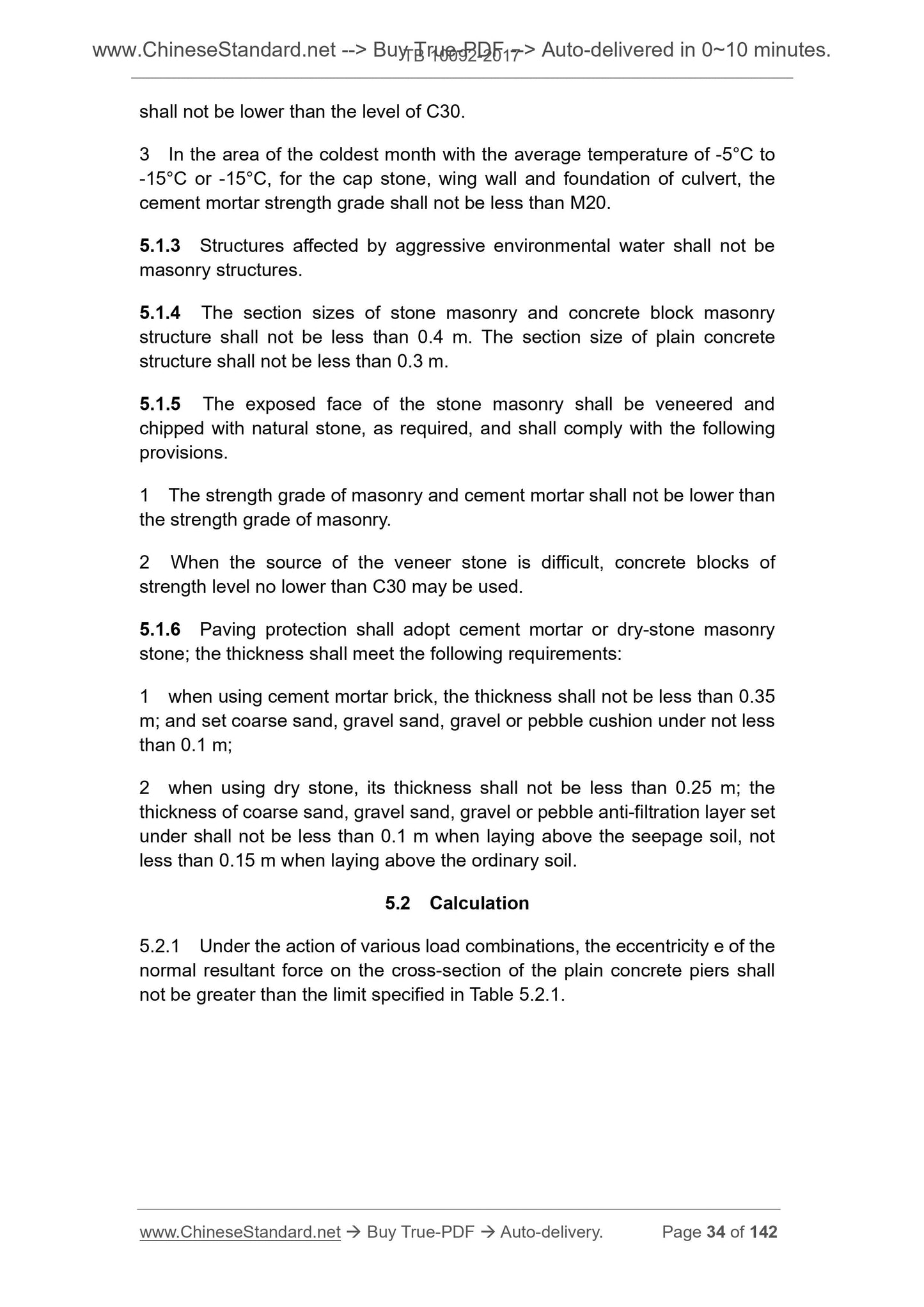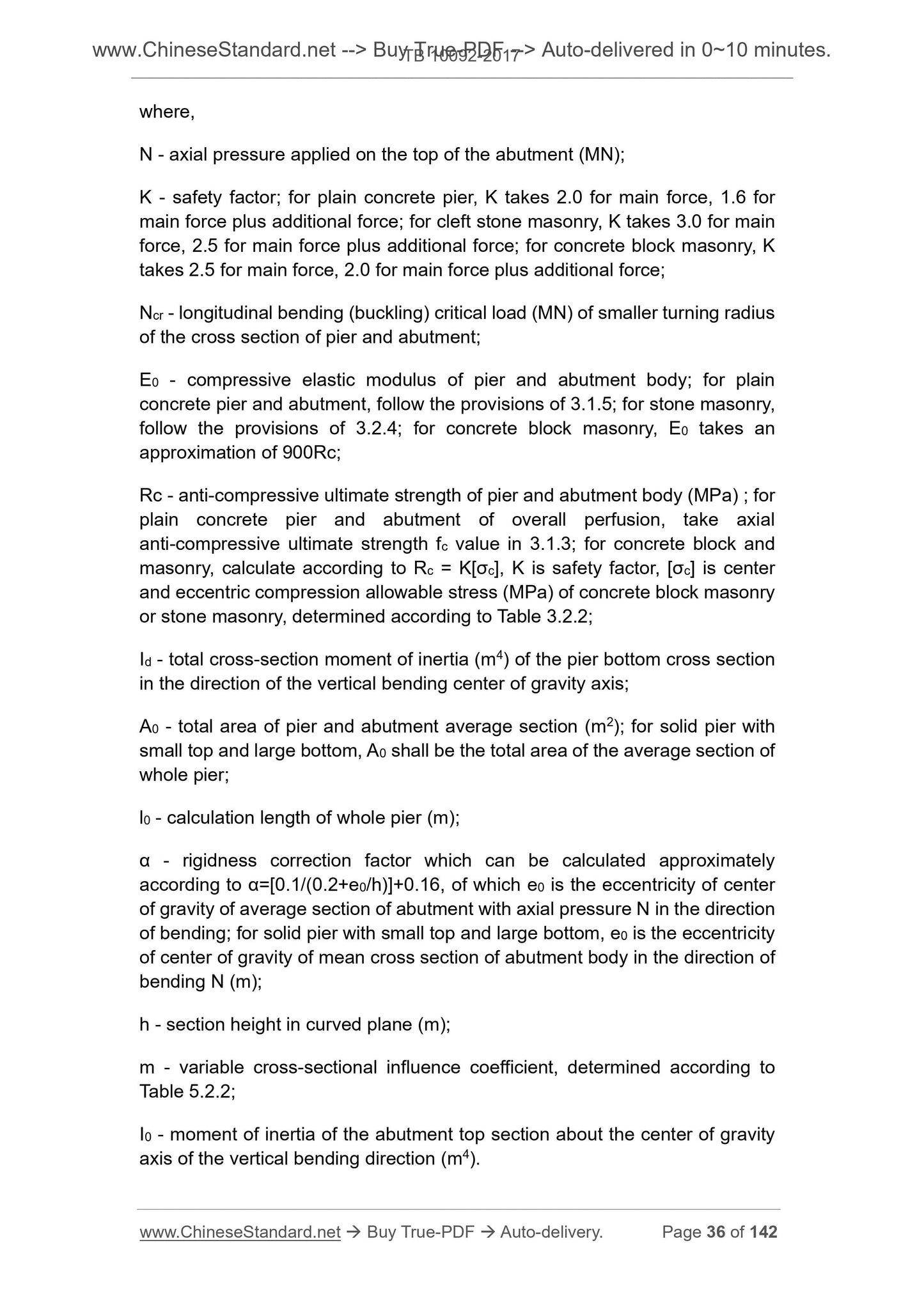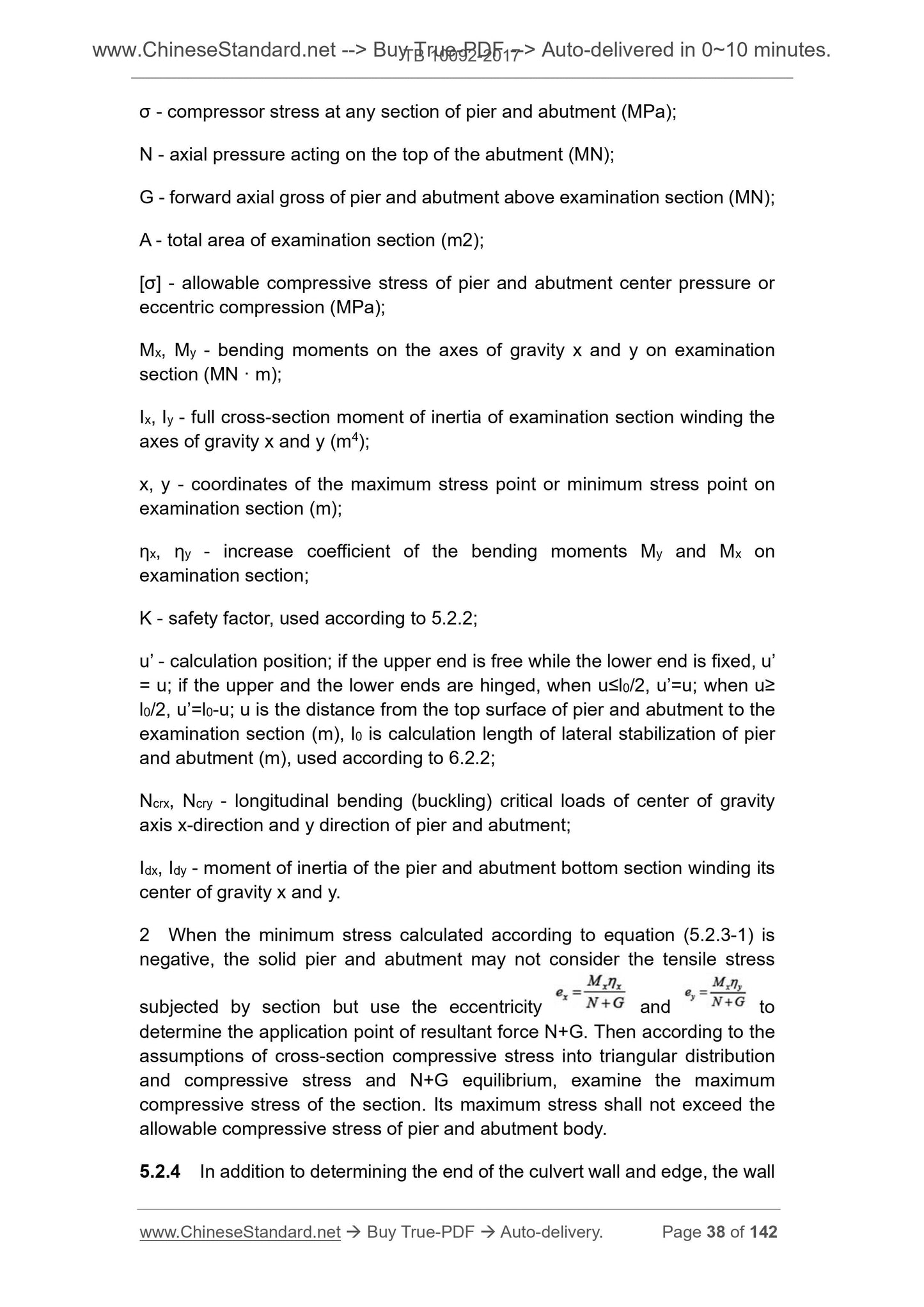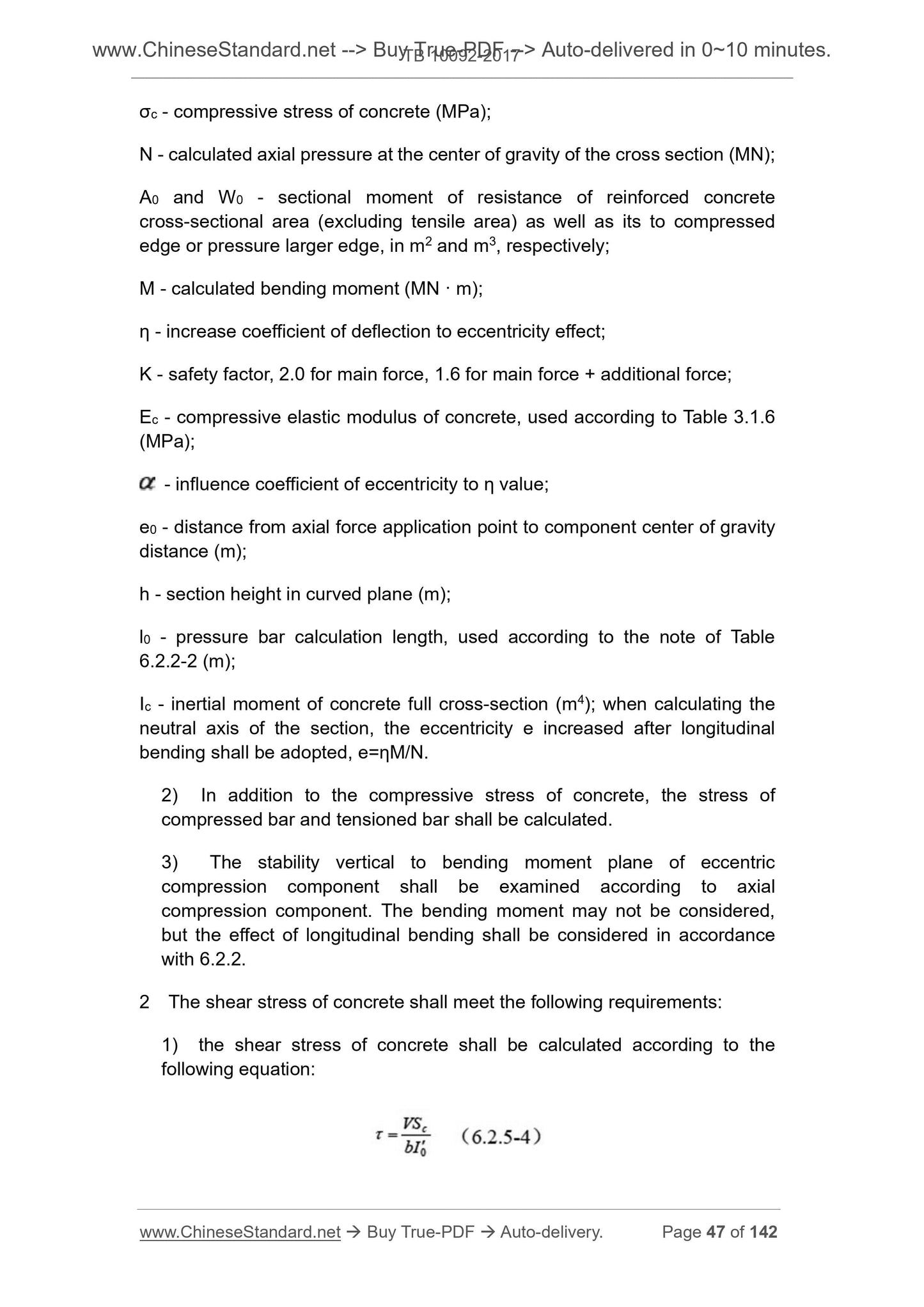1
/
of
12
www.ChineseStandard.us -- Field Test Asia Pte. Ltd.
TB 10092-2017 English PDF
TB 10092-2017 English PDF
Regular price
$760.00
Regular price
Sale price
$760.00
Unit price
/
per
Shipping calculated at checkout.
Couldn't load pickup availability
TB 10092-2017: Code for Design of Concrete Structures of Railway Bridge and Culvert
Delivery: 9 seconds. Download (& Email) true-PDF + Invoice.
Get Quotation: Click TB 10092-2017 (Self-service in 1-minute)
Historical versions (Master-website): TB 10092-2017
Preview True-PDF (Reload/Scroll-down if blank)
TB 10092-2017
TB
INDUSTRIAL STANDARD OF
THE PEOPLE’S REPUBLIC OF CHINA
UDC
J 462-2017
Code for Design of Concrete Structures
of Railway Bridge and Culvert
ISSUED ON. JANUARY 2, 2017
IMPLEMENTED ON. MAY 1, 2017
Issued by. China Railway Administration
Table of Contents
Foreword ... 4
1 General ... 7
2 Terms and symbols ... 8
3 Materials ... 14
4 Basic rules for design ... 24
5 Plain concrete and masonry structures ... 33
6 Reinforced concrete structure ... 40
7 Prestressing concrete structure ... 59
8 Bearing ... 102
9 Jacked-in bridge or culvert of existing railway ... 115
Annex A Calculation of bending moment redistribution of prestressed
concrete structure system ... 118
Annex B Calculation of thermal stress in concrete box-beam ... 123
Annex C Examination of oblique section strength of bending component of
prestressed concrete ... 132
Annex D Calculation of reverse friction of beam prestressing tendon of
post-tensioning prestressed concrete ... 136
Annex E Calculation of stress of cracked section after pressure elimination of
bending component of prestressed concrete ... 139
Instructions on wording of this Code ... 142
Foreword
Since “Code for design on reinforced and pre-stressed concrete structure of
railway bridge and culvert-including Amendment 1” (TB 10002.3-2005) and
“Code for design on concrete and block masonry structure of railway bridge
and culvert” (TB 10002.4-2005) were issued, China's railway construction,
especially high-speed rail has made remarkable achievements -
Beijing-Shanghai, Beijing-Guangzhou, Zhengzhou-Xi’an, Harbin-Dalian
high-speed rails, Yiwan, Taizhongyin and other passenger and freight
interchanges, the central-southern Shanxi access-way, Menghua and other
heavy haul rails have been opened to traffic, which has improved the road
network structure, increased the effective supply of railway transport services.
After more than a decade of active exploration and innovative practice,
China's railway bridge construction technology has made major
breakthroughs, has been among the advanced ranks of the world. A
number of successful construction of complex structural bridges of deep
water, large span, special geological conditions such as Nanjing
Dashengguan Yangtze River Bridge, Wuhan Tianxingzhou Yangtze River
Bridge together with a wide application of large tonnage box girder complete
sets of technology of independent R and D have accumulated rich experience
and laid a solid foundation for further improvement of railway bridge technical
standards.
This Code was fully revised. It summarizes the practical experience and
scientific research of China’s high-speed, intercity, passenger and freight
lines and heavy haul bridge construction, operation in recent years on the
basis of the previous specifications according to the requirements of construct
railway engineering construction standard system of China Railway
Administration, so as to meet the needs of railway bridge and culvert
construction and development, to unify the design standards of railway
bridges and culverts, to improve the design level of railway bridges and
culverts, and to ensure the safety and quality of railway bridges and culverts.
This Code implements the principle of safety first, strengthens the technical
requirements of quality and safety, saving resources, protecting the
environment. Combining with China's national conditions, economic and
social development, environmental conditions and other factors, it reasonably
determines the main design standards of railway bridges with different types
of transport and different speed grades. It further enhances the solemnity of
the Code, technical and economic rationality.
This Code consists of 9 clauses, mainly containing. general, terms and
symbols, materials, basic design rules, plain concrete and masonry structures,
reinforced concrete structures, pre-stressed concrete structures, bearings. It
also has 5 annexes.
Code for Design of Concrete Structures
of Railway Bridge and Culvert
1 General
1.0.1 This Code was formulated in order to unify the design standards for
the concrete structures of railway bridges and culverts, make the design in
conformity with the requirements of safety, reliability, advanced maturity and
economy and application.
1.0.2 This Code applies to the design of masonry, plain concrete, reinforced
concrete and pre-stressed concrete structures of railway bridges and
culverts.
1.0.3 The design of concrete structures of railway bridge and culvert shall
comply with relevant provisions of the existing “Code for Design on Steel
Structure of Railway Bridge and Culvert” (TB 10002), “Code for seismic
design of railway engineering” (GB 50111), “Code for durability design on
concrete structure of railway” (TB 10005).
1.0.4 The strength, rigidity and stability of the bridge-culvert structure shall
meet the requirements of track ride, train operation safety and passenger ride
comfort.
1.0.5 The use life of bridge and culvert concrete structures design shall be
100 years.
1.0.6 The design of concrete structures of railway bridge and culvert shall,
in addition to this Code, comply with the existing national mandatory
standards.
2 Terms and symbols
2.1 Terms
2.1.1 concrete structure
the structure made of concrete as the main building material, including plain
concrete, reinforced concrete and prestressed concrete structures
2.1.2 block masonry structure
the structure in bridge culvert built by concrete blocks or stones with cement
mortar
2.1.3 plain concrete structure
the concrete structure without reinforcement or not equipped with reinforced
tendon
2.1.4 reinforced concrete structure
the concrete structure equipped with ordinary reinforced tendon
2.1.5 prestressed concrete structure
the concrete structure equipped with forced prestressed tendon and applied
with prestress
2.1.6 bridge superstructure
the structure over beam bridge support or above arch bridge arch line,
crossing the bridge hole
2.1.7 simply supported beam
the beam supported at both ends, one end as vertical movable bearing, the
other as vertical fixed bearing
2.1.8 continuous beam
the beam supported by bearing, of beam continuous two or more spans
2.1.9 frame
the structure of load-bearing system connected by beam and column in rigid
connection or hinge connection
2.1.10 rigid frame bridge
the ability of a material or component to withstand damage when stressed; its
value is the maximum stress the material can withstand or the maximum
internal force the component can withstand
2.1.22 stiffness
the ability of a structure or component to resist deformation
2.1.23 degree of prestressing
the degree of stress created by the design load that is counteracted by
prestressing, in the structure or component
2.1.24 effective prestress
the stress in prestressed tendons before taking into account the role of
external load, after deducting the stress caused by various factors
2.1.25 deflection
the line displacement of structural component axis or some point on the
middle plane vertical to axial or middle plane direction due to deflection in the
bending moment plane
2.1.26 camber
the amount of correction that is reserved in the opposite direction to the
deflection so as to offset the deflection of bridge structure under load
2.1.27 prestressing tendon
a generic name for reinforcing steel, steel wire and strand used to apply
prestressing in concrete structural component
2.1.28 fatigue stress range
the difference between the maximum stress and the minimum stress of a
component under the fatigue load
2.2 Symbols
2.2.1 Material properties
Ec - concrete elastic modulus
Gc - concrete shear deformation modulus
vc - Poisson's ratio of concrete
- concrete shear stress
σtp, σcp - concrete main pull, main pressure stress
σcon - control stress under prestressing tendon anchor
σp - prestressing tendon tensile stress
σpl - effective prestress of prestressing tendon
σs - tensile stress of ordinary rebar
σL - stress loss of prestressing tendon
wf - crack width
Δσp, Δσs - stress amplitudes of prestressing tendon, ordinary rebar
2.2.3 Geometric parameters
b - rectangular section width; T-shape, I-shape section web width
bf, b’f - tension, compression flange width of T-shape or I-shape section
d - diameter
e - eccentricity
h - section height
hf, h’f - tension, compression flange width of T-shape or I-shape section
l0 - calculated span or calculated length
i - sectional radius of gyration
A - section area
W - sectional moment of resistance
I - sectional moment of inertia
SS - measured on the connecting lead of the center point of gravity and
synergy along with pier and abutment section, the distance from the center of
gravity of the cross section to the point of intersection of the line with the
cross-section outsourcing contour
S0 - distance from the section gravity to the edge of maximum compressive
stress
Figure 4.4.3 -- Rigid frame axis calculation diagram
4.4.4 The cross-section of the beam in the rigid frame shall be calculated
according to the relevant provisions of 4.3.
4.5 Calculation of pier and abutment
4.5.1 Pier and abutment shall meet the strength and stability requirements.
The calculation of pier and abutment shall comply with relevant provisions of
existing “Code for Design on Steel Structure of Railway Bridge” (TB 10002).
4.5.2 The eccentric of plain concrete, masonry pier and abutment shall
comply with the provisions of 5.2.1.
4.5.3 Hollow piers shall consider the local stability of the pier body,
temperature and concrete shrinkage, and the influence of the junction
between the pier and the solid transitional sect...
TB 10092-2017
TB
INDUSTRIAL STANDARD OF
THE PEOPLE’S REPUBLIC OF CHINA
UDC
J 462-2017
Code for Design of Concrete Structures
of Railway Bridge and Culvert
ISSUED ON. JANUARY 2, 2017
IMPLEMENTED ON. MAY 1, 2017
Issued by. China Railway Administration
Table of Contents
Foreword ... 4
1 General ... 7
2 Terms and symbols ... 8
3 Materials ... 14
4 Basic rules for design ... 24
5 Plain concrete and masonry structures ... 33
6 Reinforced concrete structure ... 40
7 Prestressing concrete structure ... 59
8 Bearing ... 102
9 Jacked-in bridge or culvert of existing railway ... 115
Annex A Calculation of bending moment redistribution of prestressed
concrete structure system ... 118
Annex B Calculation of thermal stress in concrete box-beam ... 123
Annex C Examination of oblique section strength of bending component of
prestressed concrete ... 132
Annex D Calculation of reverse friction of beam prestressing tendon of
post-tensioning prestressed concrete ... 136
Annex E Calculation of stress of cracked section after pressure elimination of
bending component of prestressed concrete ... 139
Instructions on wording of this Code ... 142
Foreword
Since “Code for design on reinforced and pre-stressed concrete structure of
railway bridge and culvert-including Amendment 1” (TB 10002.3-2005) and
“Code for design on concrete and block masonry structure of railway bridge
and culvert” (TB 10002.4-2005) were issued, China's railway construction,
especially high-speed rail has made remarkable achievements -
Beijing-Shanghai, Beijing-Guangzhou, Zhengzhou-Xi’an, Harbin-Dalian
high-speed rails, Yiwan, Taizhongyin and other passenger and freight
interchanges, the central-southern Shanxi access-way, Menghua and other
heavy haul rails have been opened to traffic, which has improved the road
network structure, increased the effective supply of railway transport services.
After more than a decade of active exploration and innovative practice,
China's railway bridge construction technology has made major
breakthroughs, has been among the advanced ranks of the world. A
number of successful construction of complex structural bridges of deep
water, large span, special geological conditions such as Nanjing
Dashengguan Yangtze River Bridge, Wuhan Tianxingzhou Yangtze River
Bridge together with a wide application of large tonnage box girder complete
sets of technology of independent R and D have accumulated rich experience
and laid a solid foundation for further improvement of railway bridge technical
standards.
This Code was fully revised. It summarizes the practical experience and
scientific research of China’s high-speed, intercity, passenger and freight
lines and heavy haul bridge construction, operation in recent years on the
basis of the previous specifications according to the requirements of construct
railway engineering construction standard system of China Railway
Administration, so as to meet the needs of railway bridge and culvert
construction and development, to unify the design standards of railway
bridges and culverts, to improve the design level of railway bridges and
culverts, and to ensure the safety and quality of railway bridges and culverts.
This Code implements the principle of safety first, strengthens the technical
requirements of quality and safety, saving resources, protecting the
environment. Combining with China's national conditions, economic and
social development, environmental conditions and other factors, it reasonably
determines the main design standards of railway bridges with different types
of transport and different speed grades. It further enhances the solemnity of
the Code, technical and economic rationality.
This Code consists of 9 clauses, mainly containing. general, terms and
symbols, materials, basic design rules, plain concrete and masonry structures,
reinforced concrete structures, pre-stressed concrete structures, bearings. It
also has 5 annexes.
Code for Design of Concrete Structures
of Railway Bridge and Culvert
1 General
1.0.1 This Code was formulated in or...
Delivery: 9 seconds. Download (& Email) true-PDF + Invoice.
Get Quotation: Click TB 10092-2017 (Self-service in 1-minute)
Historical versions (Master-website): TB 10092-2017
Preview True-PDF (Reload/Scroll-down if blank)
TB 10092-2017
TB
INDUSTRIAL STANDARD OF
THE PEOPLE’S REPUBLIC OF CHINA
UDC
J 462-2017
Code for Design of Concrete Structures
of Railway Bridge and Culvert
ISSUED ON. JANUARY 2, 2017
IMPLEMENTED ON. MAY 1, 2017
Issued by. China Railway Administration
Table of Contents
Foreword ... 4
1 General ... 7
2 Terms and symbols ... 8
3 Materials ... 14
4 Basic rules for design ... 24
5 Plain concrete and masonry structures ... 33
6 Reinforced concrete structure ... 40
7 Prestressing concrete structure ... 59
8 Bearing ... 102
9 Jacked-in bridge or culvert of existing railway ... 115
Annex A Calculation of bending moment redistribution of prestressed
concrete structure system ... 118
Annex B Calculation of thermal stress in concrete box-beam ... 123
Annex C Examination of oblique section strength of bending component of
prestressed concrete ... 132
Annex D Calculation of reverse friction of beam prestressing tendon of
post-tensioning prestressed concrete ... 136
Annex E Calculation of stress of cracked section after pressure elimination of
bending component of prestressed concrete ... 139
Instructions on wording of this Code ... 142
Foreword
Since “Code for design on reinforced and pre-stressed concrete structure of
railway bridge and culvert-including Amendment 1” (TB 10002.3-2005) and
“Code for design on concrete and block masonry structure of railway bridge
and culvert” (TB 10002.4-2005) were issued, China's railway construction,
especially high-speed rail has made remarkable achievements -
Beijing-Shanghai, Beijing-Guangzhou, Zhengzhou-Xi’an, Harbin-Dalian
high-speed rails, Yiwan, Taizhongyin and other passenger and freight
interchanges, the central-southern Shanxi access-way, Menghua and other
heavy haul rails have been opened to traffic, which has improved the road
network structure, increased the effective supply of railway transport services.
After more than a decade of active exploration and innovative practice,
China's railway bridge construction technology has made major
breakthroughs, has been among the advanced ranks of the world. A
number of successful construction of complex structural bridges of deep
water, large span, special geological conditions such as Nanjing
Dashengguan Yangtze River Bridge, Wuhan Tianxingzhou Yangtze River
Bridge together with a wide application of large tonnage box girder complete
sets of technology of independent R and D have accumulated rich experience
and laid a solid foundation for further improvement of railway bridge technical
standards.
This Code was fully revised. It summarizes the practical experience and
scientific research of China’s high-speed, intercity, passenger and freight
lines and heavy haul bridge construction, operation in recent years on the
basis of the previous specifications according to the requirements of construct
railway engineering construction standard system of China Railway
Administration, so as to meet the needs of railway bridge and culvert
construction and development, to unify the design standards of railway
bridges and culverts, to improve the design level of railway bridges and
culverts, and to ensure the safety and quality of railway bridges and culverts.
This Code implements the principle of safety first, strengthens the technical
requirements of quality and safety, saving resources, protecting the
environment. Combining with China's national conditions, economic and
social development, environmental conditions and other factors, it reasonably
determines the main design standards of railway bridges with different types
of transport and different speed grades. It further enhances the solemnity of
the Code, technical and economic rationality.
This Code consists of 9 clauses, mainly containing. general, terms and
symbols, materials, basic design rules, plain concrete and masonry structures,
reinforced concrete structures, pre-stressed concrete structures, bearings. It
also has 5 annexes.
Code for Design of Concrete Structures
of Railway Bridge and Culvert
1 General
1.0.1 This Code was formulated in order to unify the design standards for
the concrete structures of railway bridges and culverts, make the design in
conformity with the requirements of safety, reliability, advanced maturity and
economy and application.
1.0.2 This Code applies to the design of masonry, plain concrete, reinforced
concrete and pre-stressed concrete structures of railway bridges and
culverts.
1.0.3 The design of concrete structures of railway bridge and culvert shall
comply with relevant provisions of the existing “Code for Design on Steel
Structure of Railway Bridge and Culvert” (TB 10002), “Code for seismic
design of railway engineering” (GB 50111), “Code for durability design on
concrete structure of railway” (TB 10005).
1.0.4 The strength, rigidity and stability of the bridge-culvert structure shall
meet the requirements of track ride, train operation safety and passenger ride
comfort.
1.0.5 The use life of bridge and culvert concrete structures design shall be
100 years.
1.0.6 The design of concrete structures of railway bridge and culvert shall,
in addition to this Code, comply with the existing national mandatory
standards.
2 Terms and symbols
2.1 Terms
2.1.1 concrete structure
the structure made of concrete as the main building material, including plain
concrete, reinforced concrete and prestressed concrete structures
2.1.2 block masonry structure
the structure in bridge culvert built by concrete blocks or stones with cement
mortar
2.1.3 plain concrete structure
the concrete structure without reinforcement or not equipped with reinforced
tendon
2.1.4 reinforced concrete structure
the concrete structure equipped with ordinary reinforced tendon
2.1.5 prestressed concrete structure
the concrete structure equipped with forced prestressed tendon and applied
with prestress
2.1.6 bridge superstructure
the structure over beam bridge support or above arch bridge arch line,
crossing the bridge hole
2.1.7 simply supported beam
the beam supported at both ends, one end as vertical movable bearing, the
other as vertical fixed bearing
2.1.8 continuous beam
the beam supported by bearing, of beam continuous two or more spans
2.1.9 frame
the structure of load-bearing system connected by beam and column in rigid
connection or hinge connection
2.1.10 rigid frame bridge
the ability of a material or component to withstand damage when stressed; its
value is the maximum stress the material can withstand or the maximum
internal force the component can withstand
2.1.22 stiffness
the ability of a structure or component to resist deformation
2.1.23 degree of prestressing
the degree of stress created by the design load that is counteracted by
prestressing, in the structure or component
2.1.24 effective prestress
the stress in prestressed tendons before taking into account the role of
external load, after deducting the stress caused by various factors
2.1.25 deflection
the line displacement of structural component axis or some point on the
middle plane vertical to axial or middle plane direction due to deflection in the
bending moment plane
2.1.26 camber
the amount of correction that is reserved in the opposite direction to the
deflection so as to offset the deflection of bridge structure under load
2.1.27 prestressing tendon
a generic name for reinforcing steel, steel wire and strand used to apply
prestressing in concrete structural component
2.1.28 fatigue stress range
the difference between the maximum stress and the minimum stress of a
component under the fatigue load
2.2 Symbols
2.2.1 Material properties
Ec - concrete elastic modulus
Gc - concrete shear deformation modulus
vc - Poisson's ratio of concrete
- concrete shear stress
σtp, σcp - concrete main pull, main pressure stress
σcon - control stress under prestressing tendon anchor
σp - prestressing tendon tensile stress
σpl - effective prestress of prestressing tendon
σs - tensile stress of ordinary rebar
σL - stress loss of prestressing tendon
wf - crack width
Δσp, Δσs - stress amplitudes of prestressing tendon, ordinary rebar
2.2.3 Geometric parameters
b - rectangular section width; T-shape, I-shape section web width
bf, b’f - tension, compression flange width of T-shape or I-shape section
d - diameter
e - eccentricity
h - section height
hf, h’f - tension, compression flange width of T-shape or I-shape section
l0 - calculated span or calculated length
i - sectional radius of gyration
A - section area
W - sectional moment of resistance
I - sectional moment of inertia
SS - measured on the connecting lead of the center point of gravity and
synergy along with pier and abutment section, the distance from the center of
gravity of the cross section to the point of intersection of the line with the
cross-section outsourcing contour
S0 - distance from the section gravity to the edge of maximum compressive
stress
Figure 4.4.3 -- Rigid frame axis calculation diagram
4.4.4 The cross-section of the beam in the rigid frame shall be calculated
according to the relevant provisions of 4.3.
4.5 Calculation of pier and abutment
4.5.1 Pier and abutment shall meet the strength and stability requirements.
The calculation of pier and abutment shall comply with relevant provisions of
existing “Code for Design on Steel Structure of Railway Bridge” (TB 10002).
4.5.2 The eccentric of plain concrete, masonry pier and abutment shall
comply with the provisions of 5.2.1.
4.5.3 Hollow piers shall consider the local stability of the pier body,
temperature and concrete shrinkage, and the influence of the junction
between the pier and the solid transitional sect...
TB 10092-2017
TB
INDUSTRIAL STANDARD OF
THE PEOPLE’S REPUBLIC OF CHINA
UDC
J 462-2017
Code for Design of Concrete Structures
of Railway Bridge and Culvert
ISSUED ON. JANUARY 2, 2017
IMPLEMENTED ON. MAY 1, 2017
Issued by. China Railway Administration
Table of Contents
Foreword ... 4
1 General ... 7
2 Terms and symbols ... 8
3 Materials ... 14
4 Basic rules for design ... 24
5 Plain concrete and masonry structures ... 33
6 Reinforced concrete structure ... 40
7 Prestressing concrete structure ... 59
8 Bearing ... 102
9 Jacked-in bridge or culvert of existing railway ... 115
Annex A Calculation of bending moment redistribution of prestressed
concrete structure system ... 118
Annex B Calculation of thermal stress in concrete box-beam ... 123
Annex C Examination of oblique section strength of bending component of
prestressed concrete ... 132
Annex D Calculation of reverse friction of beam prestressing tendon of
post-tensioning prestressed concrete ... 136
Annex E Calculation of stress of cracked section after pressure elimination of
bending component of prestressed concrete ... 139
Instructions on wording of this Code ... 142
Foreword
Since “Code for design on reinforced and pre-stressed concrete structure of
railway bridge and culvert-including Amendment 1” (TB 10002.3-2005) and
“Code for design on concrete and block masonry structure of railway bridge
and culvert” (TB 10002.4-2005) were issued, China's railway construction,
especially high-speed rail has made remarkable achievements -
Beijing-Shanghai, Beijing-Guangzhou, Zhengzhou-Xi’an, Harbin-Dalian
high-speed rails, Yiwan, Taizhongyin and other passenger and freight
interchanges, the central-southern Shanxi access-way, Menghua and other
heavy haul rails have been opened to traffic, which has improved the road
network structure, increased the effective supply of railway transport services.
After more than a decade of active exploration and innovative practice,
China's railway bridge construction technology has made major
breakthroughs, has been among the advanced ranks of the world. A
number of successful construction of complex structural bridges of deep
water, large span, special geological conditions such as Nanjing
Dashengguan Yangtze River Bridge, Wuhan Tianxingzhou Yangtze River
Bridge together with a wide application of large tonnage box girder complete
sets of technology of independent R and D have accumulated rich experience
and laid a solid foundation for further improvement of railway bridge technical
standards.
This Code was fully revised. It summarizes the practical experience and
scientific research of China’s high-speed, intercity, passenger and freight
lines and heavy haul bridge construction, operation in recent years on the
basis of the previous specifications according to the requirements of construct
railway engineering construction standard system of China Railway
Administration, so as to meet the needs of railway bridge and culvert
construction and development, to unify the design standards of railway
bridges and culverts, to improve the design level of railway bridges and
culverts, and to ensure the safety and quality of railway bridges and culverts.
This Code implements the principle of safety first, strengthens the technical
requirements of quality and safety, saving resources, protecting the
environment. Combining with China's national conditions, economic and
social development, environmental conditions and other factors, it reasonably
determines the main design standards of railway bridges with different types
of transport and different speed grades. It further enhances the solemnity of
the Code, technical and economic rationality.
This Code consists of 9 clauses, mainly containing. general, terms and
symbols, materials, basic design rules, plain concrete and masonry structures,
reinforced concrete structures, pre-stressed concrete structures, bearings. It
also has 5 annexes.
Code for Design of Concrete Structures
of Railway Bridge and Culvert
1 General
1.0.1 This Code was formulated in or...
Share
